People
Mermaid Tails, Haunted Snow Globes, and the Myth of the American Dream: The Distinct Millennial-Defining Art of Olivia Erlanger
The 30-year-old artist is showing her quarantine-era work at Soft Opening in London.
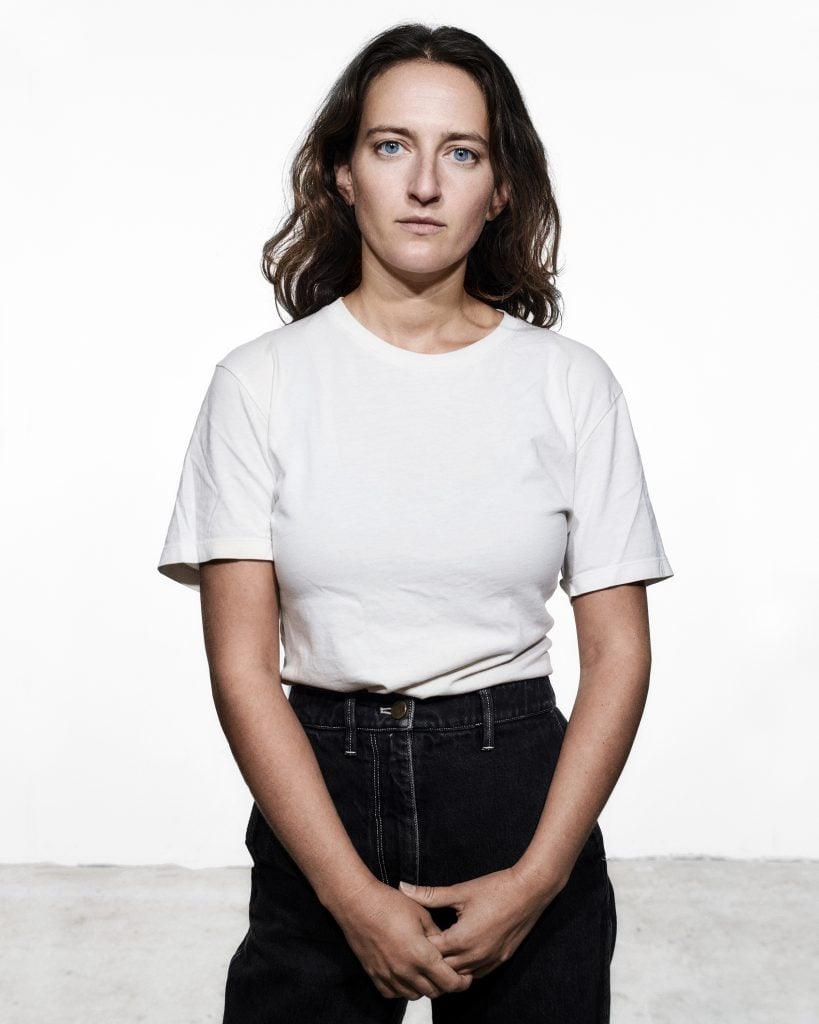
The 30-year-old artist is showing her quarantine-era work at Soft Opening in London.

Taylor Dafoe

Three years ago, artist Olivia Erlanger rescued actress Aubrey Plaza from a marijuana farm run by nuns in the dusty heart of California.
Erlanger was at work on what would become Garage (2019), the documentary film follow-up to her book of the same name about the history of the titular suburban enclave—birthplace of countless bands, businesses, and forgotten home gyms. The artist was in search of characters to portray what she and her co-author, architect Luis Ortega Govela, had identified as the seven archetypes of garage users when she met the Sisters of the Valley, members of a feminist permaculture collective that launched a marijuana company in the name of boosting land ownership among women.
“I think we all were envisioning the Sound of Music at a lush weed farm,” Erlanger told Artnet News over video chat in October. “But what we found was a shared compound, a small garden with a few marijuana plants, and some women dressed as nuns drinking out of red solo cups. We didn’t know what was going on.”
Adding to the strangeness was the unlikely presence of Plaza, far from Hollywood and stoned out of her gourd. There to promote her new film about nuns by lighting up with the Sisters, she approached Erlanger’s team and asked them not to leave without her. “I told her we were staying at a Best Western around the corner and she was like, ‘Perfect. Take me with you,'” the artist recalled.
The day ended okay; Plaza sobered up, and the nuns—who, if you haven’t guessed by now, weren’t actual nuns—earned a starring role in Erlanger’s documentary. (Plaza made an appearance, too.)
We begin here because this story, while entertaining, is also pure Erlanger.
A movie star trapped in Steinbeck’s California, a bizarre entrepreneurial scheme devised around an illegal cash crop—it all smacks of the strange recipe at the heart of Erlanger’s art. There’s a healthy dose of American mythology, a splash of environmental economics, and a pinch of Lynchian theater.
Erlanger, in other words, is the quintessential artist for an era we’ve come to describe as surreal because we don’t have a better adjective. Born in 1990—a time of prosperity and belief in the American Dream—she witnessed that promise get punctured by the Great Recession and the rise of Donald Trump.
Her work embodies the experience of a millennial who has seen the rules of the game change without warning.
Erlanger, now 30, is effusive and easy to talk to. She spoke with us from a friend’s plant-filled apartment in Brooklyn, just after the launch of her new show at Soft Opening in London. After several years living in LA, she’s found herself without a permanent address. The peripatetic setup is a reminder of how young the artist is—something that’s easy to forget given the sophistication of her work, and the sheer amount of it she’s produced over the past seven years.
“Olivia’s work investigates how the different kinds of collapse in economics and ecologies influence the recent fracturing of identity,” summed up curator Attilia Fattori Franchini, who worked with Erlanger on a installation at Frieze London in 2017 that emitted blue light and fog in response to fluctuations in the price of oil. “She is exploring American folklore and symbols of the middle class from a feminist and cinematic perspective.”
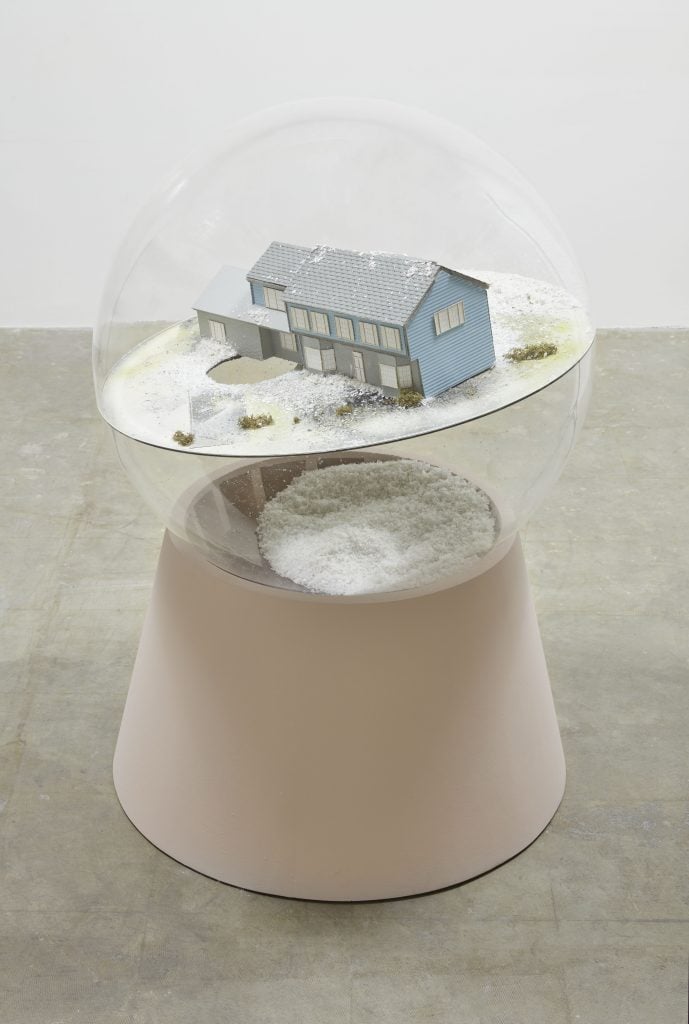
Olivia Erlanger, Soft Kiss (2020). Courtesy of the artist and Bel Ami.
Erlanger was born in New York, the daughter of a couple in finance. When she was a child, her family decamped to a commuter town in Connecticut—a paradigmatic suburban experience that would come to cast a large shadow over her artistic output.
In an elementary school art class, she recreated—to exacting degree—an Absolut Vodka ad. Her parents were called in. “They were actually very proud of me,” Erlanger said with a smile. “They told me that this was a sure sign that I was destined to be an artist because I had started a conversation—and a little controversy. After that, I knew what I wanted to do.”
Her father patented IP around a new marketplace designed to increase transparency in home loans and lines of credit—a precursor to what would become blockchain technology. But the burst of the housing bubble hit her family hard, and they sold their Connecticut home around the time Erlanger headed to college.
“I grew up with a conceptual conversation around the home as a financial instrument,” she recalled, “while actually experiencing the fallout of the home as a financial instrument on a global scale.”
In college, at Lewis & Clark—then, briefly, Parsons, and then Lewis & Clark again—she studied sculpture and literature. After graduation, Erlanger traveled on a whim to Berlin, hoping to meet several artists she knew only through Facebook. It led, circuitously, to her first significant show, at Fluxia Gallery in Milan, in 2014. She was just 23.
She returned to New York and took up a pair of jobs: one as a bookkeeper for an architectural firm, and another as an assistant to artist Anicka Yi. (She helped collect samples for Yi’s breakthrough 2015 show “You Can Call Me F,” in which the Korean-American artist synthesized biological material from 100 women into a single, backlit bacterium.)
Erlanger’s artistic career began to pick up speed in 2016, when she secured solo shows at What Pipeline in Detroit (she showed “raft” assemblages made of resin, bee pollen, and blinds) and Mathew gallery in Manhattan (for which she created a filing cabinet filled with mud and red light that varied in intensity according to fluctuations in the Mercantile Stock Exchange). But her big breakthrough did not come until she moved to Los Angeles the following year.
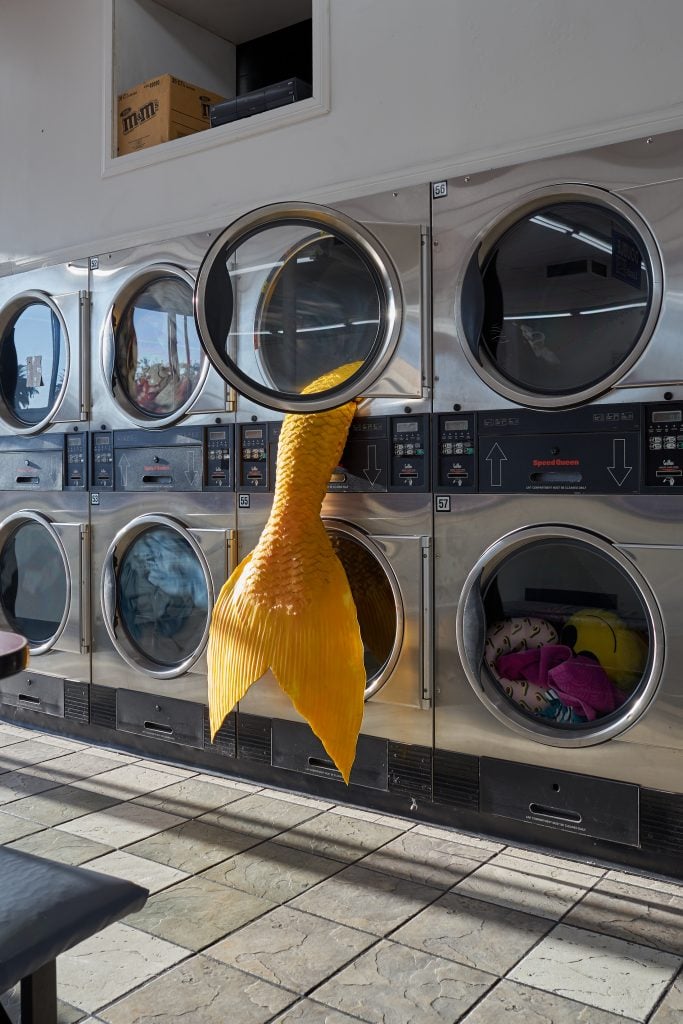
Installation view of “Olivia Erlanger: Ida,” 2018. Courtesy of the artist and Mother Culture.
In LA, Erlanger seized on another middle-class space, the laundromat, to stage what would become her most recognizable—and certainly her most Instagrammed—project to date. Inside a modest storefront, she created a surreal tableau: silicone mermaid tails dangling lifelessly from washing machine and drier doors. (The project, mounted by the experiential art space Mother Culture in 2018, has been revived at Frieze New York in 2019 and at the Daelim Museum in Seoul, South Korea this year.)
The scene feels more like a trippy funhouse than a reference-laden cultural commentary. But it is emblematic of the way research forms the backbone of Erlanger’s work. The installation was inspired by an essay that posits The Little Mermaid as a feminist metaphor for female hysteria. (The show was titled Ida after Ida Bauer, a patient of Sigmund Freud’s who was diagnosed with hysteria after losing her voice—just as Ariel does in Disney’s interpretation of the Hans Christian Andersen tale.)
Erlanger’s not dogmatic: she seems open to all readings of her work, and for all the magical realism in Ida, there must be many. The idea itself came from a playful misreading of a wall-mounted sculpture of a pair of snake tongues in Erlanger’s show at Mathew. A friend’s child identified them as mermaid tails.
“I had just never perceived them that way,” Erlanger said. “It’s as simple as the conversation around the work led me to a new way to access thinking through the pieces.”
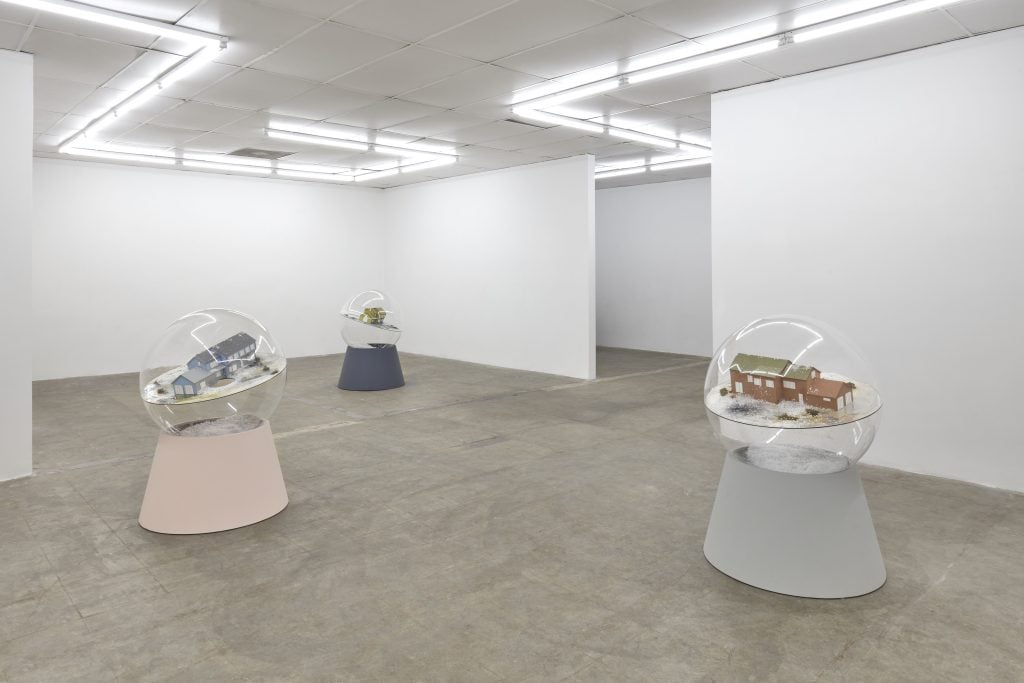
Installation view of “Olivia Erlanger: Split-level Paradise,” 2020. Courtesy of the artist and Bel Ami.
Erlanger’s 2020 is bookended with a pair of shows that similarly marry the fantastical with the domestic—and they feel almost eerily quarantine-y.
“Split-level Paradise,” her show at Bel Ami gallery in LA that closed the week the country went into lockdown in March, comprised three snow-globe-shaped sculptures the size of La-Z-Boys. In the top half of each orb sits a two-story, ticky tacky home painted in wan colors—an almost comic literalization of the phrase “housing bubble.”
Fake snow pools at the bottom, ready to be jolted into a winter wonderland. But the sculptures aren’t shakable; the snow is stuck and the homes suddenly read as Truman Show-style traps. It’s not a stretch to project the artist’s own suburban experience onto them.
“I think that was at the core of it: how do you make a memory?” Erlanger mused. “How do you make an art that is a memory and how do you examine the ways in which we protect those memories, creating idealized or perfect moments? The myth of home ownership in America is very much tied to that same protective measure of a fascination with an ideal that truly no longer exists and is contested throughout the history of the development of suburbia.”
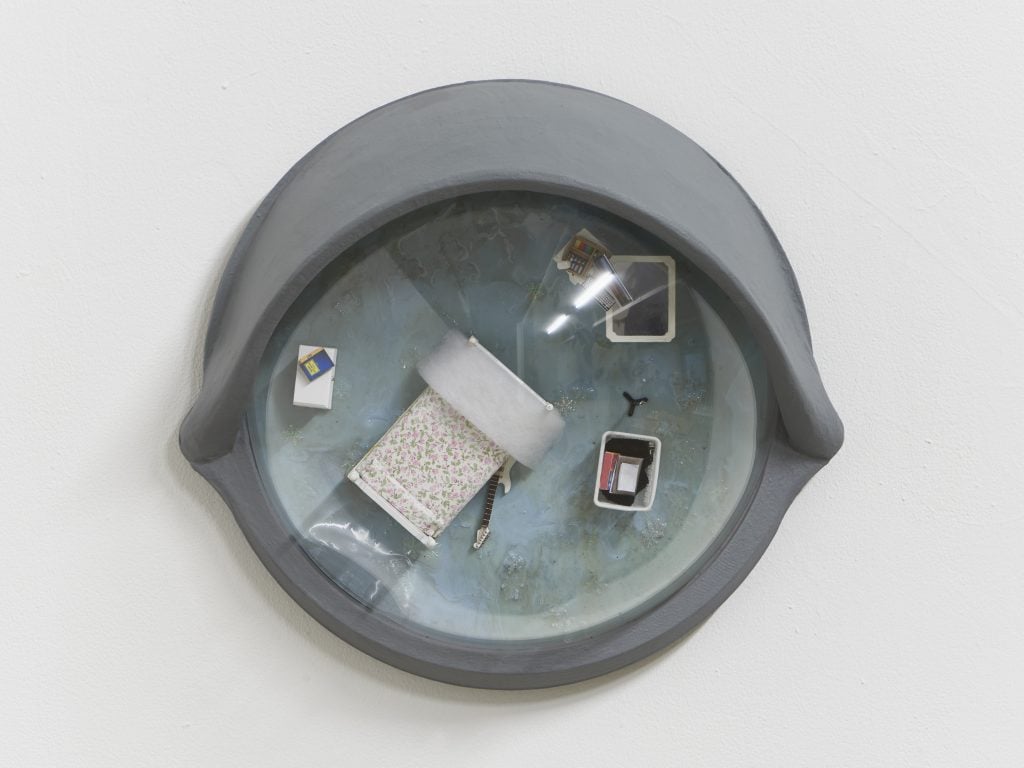
Olivia Erlanger, 11:34 AM, 2020 (2020). Courtesy of the artist and Soft Opening.
Six and a half months separated that show and “Home is a Body,” her new exhibition at Soft Opening. That was enough time for a virus to take hold of the world and force us all inside our own little bubbles, and the new series reflects that sense of isolation.
Lining the gallery walls is a suite of domed sculptures that resemble both apartment-door peepholes and human eyes. Each is named after a different time of day and inside are different domestic scenes—a disheveled basement, a bare-bones bathroom—devoid of inhabitants.
“There’s always a flirtation with the uncanny in Olivia’s work that I think is immediately recognizable,” said Antonia Marsh, Soft Opening’s director. “I’d spot her self-aware engagement with the American Dream turned delusion—imagery that might seem to reflect a picture-postcard America but with a distinctly dystopic, Ballardian twist.”
While Erlanger emphasizes the research that goes into her work, she acknowledges it’s driven by a desire to mine her own history. “How else do you become obsessed with examining the idea of home and the American Dream,” she asked, “without a personal relationship to it?”